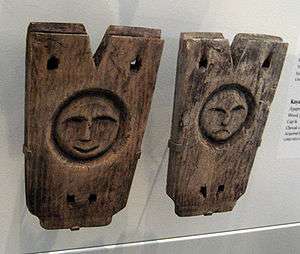Stanchion

Stanchions and velvet rope
A stanchion (/ˈstænʃən/) is a sturdy upright fixture that provides support for some other object.[1] They can be a permanent fixture.
Types
- An event management term applied to an upright bar or post that includes retractable belts, velvet ropes, or plastic chains, sometimes in conjunction with wall-mounted barrier devices,[2] and often used for crowd control and engineering people flow.
- An architectural term applied to the upright iron bars in windows that pass through the eyes of the saddle bars or horizontal irons to steady the leadlight. (The French call the latter traverses, the stanchions montants, and the whole arrangement armature. Stanchions frequently finish with ornamental heads forged out of the iron.)
- An architectural term applied to metal supporting members of lighting mounted from a lower elevation. This includes:
- The metal inclined member for mounting a streetlight to a telephone or power pole.
- The dedicated metal vertical support of a self-supporting or bottom-fed streetlight. In this case, the stanchion pole may double as the raceway for the electrical feed to the lighting.
- In industrial installations, walkway lighting may be mounted with a stanchion that is secured to a hand-rail. Stanchion lights are typically spaced 50' along walkways, such as conveyor platforms.
- Upright posts inserted into the ground or floor to protect the corner of a wall. These may also be referred to as balusters or bollards.
Uses
.png)
Stanchion
Stanchions are used for many different purposes including crowd control & waiting lines. Many different places use stanchions including banks, stores, hotels, museums, restaurants, concert venues, trade shows & other events.[3]
- Portable posts used to manage lines and queues.
- Fixed posts with decorative ropes
- Retractable belt stanchions
- Using a spring mechanism
- Using a weighted pulley system

- Vertical support for chains or ropes, as in marine applications (lifelines on yachts are supported by stanchions).
- Metal mounts securing the headrest to the seat in a car.
- In association football and other goal-based sports, horizontal or diagonal extensions to the goalposts that prevent the goalnet from drooping.
- In military aircraft, the vertical supports for troop seating temporarily installed in cargo aircraft.
- On board most buses and trams/subways, vertical supports to provide stability when passengers are standing. They are located throughout most city buses and are connected to seats, floor, roof, etc.
- The metal head bails in dairy barns that lock the cows in place while they are milked.
- The two upper members of a suspension bicycle fork that connect to the crown (also called fork legs).
- In yachting, metal bars that hold the life-lines around a boat's perimeter.
- In river rafting, metal bars that hold the yokes for oars.
- As part of ice hockey rink boards, used to hold panes of glass in place.
- The upright part of the frame around a windscreen (the A pillar).
See also
References
| Look up stanchion in Wiktionary, the free dictionary. |
- ↑ "Stanchion - Definition and More". Merriam-Webster. Retrieved 8 July 2012.
- ↑ "Stanchion Buying Guide". Stanchion Experts. Retrieved 8 July 2012.
- ↑ "Stanchions". CrowdControlExperts.com. Retrieved 8 July 2012.
![]() This article incorporates text from a publication now in the public domain: Chisholm, Hugh, ed. (1911). "article name needed". Encyclopædia Britannica (11th ed.). Cambridge University Press.
This article incorporates text from a publication now in the public domain: Chisholm, Hugh, ed. (1911). "article name needed". Encyclopædia Britannica (11th ed.). Cambridge University Press.
This article is issued from Wikipedia - version of the 10/28/2016. The text is available under the Creative Commons Attribution/Share Alike but additional terms may apply for the media files.